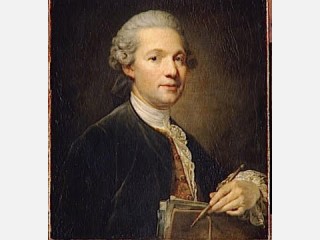
Ange-Jacques Gabriel (En.) biography
Date of birth : 1698-10-23
Date of death : 1782-01-04
Birthplace : Paris, France
Nationality : French
Category : Arhitecture and Engineering
Last modified : 2010-12-03
Credited as : Architect, Pavillon Butard, Place de la Bourse, Bordeaux
The buildings of the French architect Ange-Jacques Gabriel demonstrate elegant proportional relationships and superlative Gallic taste in the control of the dynamic expressiveness inherited from ancient Rome.
Ange-Jacques Gabriel was the most eminent 18th-century member of a family dynasty of architects descending from Jules Hardouin Mansart, first architect to King Louis XIV, with whom Ange Jacques's grandfather, Jacques IV Gabriel, and father, Jacques V Gabriel, had worked. Though Ange Jacques's early training is thought to have taken place under the architect Antoine Desgodetz, it was largely the execution of his father's designs for Paris town houses that formed his education.
At the age of 30 Ange Jacques Gabriel was launched professionally, having married Catherine de la Motte, daughter of the secretary of the Duc d'Antin, who had succeeded Mansart as superintendent of the royal buildings, and having received as a wedding gift from his father the influential post of controller of the king's buildings. Soon after his father became first architect to King Louis XV in 1734, Ange Jacques's grandiose architectural projects aroused the King's interest. Finances, however, restricted his activity to existing palaces: building the forecourt of the château at Fontainebleau (1737), restoring the Louvre in Paris (from 1755), and making internal adjustments at Versailles to create les petits appartements (1738-1753).
On his father's death in 1742 Ange Jacques Gabriel became first architect, a position he held until 1775. He lived in the Orangerie of the Tuileries Palace, and the King gave him a property at Versailles. His career was plagued by the bitter enmity of the new superintendent of buildings, the Marquis de Marigny, Madame de Pompadour's brother, and by a continual shortage of royal funds.
Gabriel's major works were executed between 1750 and 1774. The publication of J. D. Leroy's Ruines des plus beaux monuments de la Grèce (1758) coincided with Gabriel's adoption of a purer Greek style where, according to C. N. Cochin, "only the right angle makes a good effect." This was indicative of the abandonment of the curved and asymmetrical effects of the preceding rococo period. In truth, the French preference for more than a century had been the Greco-Roman esthetic of imposing weight with heavy ornamental adjuncts. Though this ideal remained apparent in Gabriel's works, his tendency was toward purifying the cubic mass and minimizing decorative accessories. This evolution is seen by comparing two of his works: the block pavilions flanking the entrance gates of the Ecole Militaire in Paris (1751-1775) and the less ponderous, elegant sobriety of the Petit Trianon at Versailles (1762-1764), the most superb work of domestic architecture of the 18th century. Other major projects reveal experimentation within this basic, formulating inclination from Roman nobility toward Greek simplicity: the chateau at Compiogne (1752), the Place Louis XV (today Place de la Concorde) in Paris (1752-1765), the Salle de l'Opera at Versailles (1753-1770), and the colonnaded terminating bays of the wings of the Cours d'Honneur at Versailles (1772).
All these works reveal bold assurance in the choice and arrangement of architectural forms and the harmonious integration of disparate parts of building complexes and terrains, gratifying the viewer with the sense of the conclusive correctness of the ensemble from any viewpoint, the result, no doubt, of Gabriel's experience with his father in city planning, notably the Place Royale (now Place de la Bourse) in Bordeaux (1731-1755).
Although the definitive monograph on Gabriel is in French, there are two satisfactory works in English. Sir Reginal Blomfield, Six Architects (1935), originally delivered as lectures at the University College of Wales, includes a delightful lecture on Gabriel that provides information on his life. H. Bartle Cox, Ange-Jacques Gabriel (1926), is a terse, objective study.
Major works
* Extension and transformations at the Château de Choisy, 1740-1777
* Château de Compiègne, 1750 onwards
* The Pavillon du Butard, 1750 at La Celle-Saint-Cloud.
* Place de la Bourse, Bordeaux, 1755 (as Place Royale
* Extension of the Château de Menars (Loir-et-Cher), 1760-1764, for Madame de Pompadour
* Petit Trianon, at Versailles, 1762 to 1768
* L'École Militaire on the Champ de Mars, Paris
* L'Opéra at the Château de Versailles, 1769-70
* Place de la Concorde (as Place Louis XV), 1772
* Hôtel de la Marine, Place de la Concorde, 1775
* Hôtel de Crillon, Place de la Concourde
















